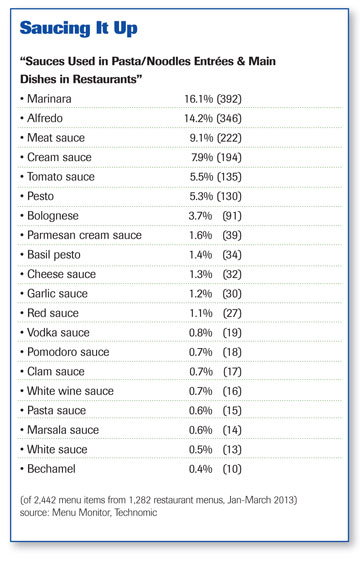|
Pasta Shapes Up
Penne, elbows and rotini are some of the leading dried pasta in today’s market, but artful noodles are another way to dress up pasta dishes. Barilla Inc. has made good use of its Italian roots in promoting shapes once unusual to mainstream America. One of its most recent, popular pastas is radiator -- pasta that literally looks like little radiators. (The automotive-themed chain restaurant Quaker Steak and Lube carries it on its menu.)
“A noodle such as radiato, gemelli, campanelli and bucatini maximizes the surface area, while the ridges or channels easily trap a thick sauce,” says Barilla chef Lorenzo Boni. “Almost all shapes have a traditional origin or specific region, and the classic dish associated with it is connected with the shape’s functionality. For example, bucatini, like a hollow spaghetti, is from Rome and typically pairs with the dish Amatriciana. The hole in the middle of the long noodle is a tasty reservoir for the spicy, meaty sauce.”
There always will be a consumer desire for comfortable and familiar shapes, like elbows and shells, but having a wide assortment of shapes on offer helps meet the demand for something new.
“Keeping the familiar, while slowly introducing new varieties, is the current market trend being seen across all pasta varieties,” says Boni.
|
No Assembly Required

Sauce Specifics
Helpful Hydrocolloids
|
Say Cheese, Please
According to the USDA, mozzarella is the most popular cheese in the U.S.; the average American eats 11.43lbs of mozzarella per year, compared to just 9.98lbs of Cheddar. However, it’s the simplicity of soft cheeses (all that’s needed is milk, some acid and a 2-hour minimum), like chèvre (soft goat cheese), ricotta and burrata, that inspire restaurant chefs to take cheese-making into their own hands and have an even more impressive DIY menu. During the recession, cheese was in a slump, but sales are up again in the U.S. And, in addition to popular mozzarella and Cheddar, consumers are reaching for specialty blues, Muenster and Asiago, as well.
|






